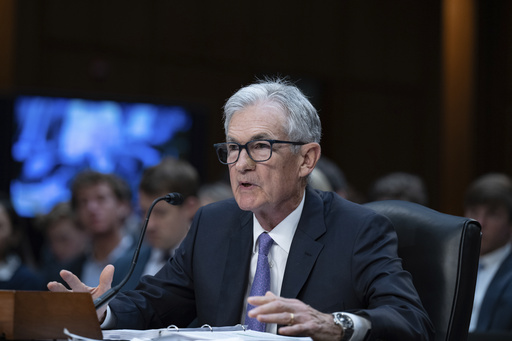WASHINGTON (AP) — The Federal Reserve faces a cooling job market as well as persistently high prices, Chair Jerome Powell said in testimony Tuesday to Congress, a shift in emphasis away from the Fed’s single-minded fight against inflation of the past two years that suggests it is moving closer to cutting interest rates.
The Fed has made “considerable progress” toward its goal of defeating the worst inflation spike in four decades, Powell told the Senate Banking Committee.
“Inflation has eased notably” in the past two years, he added, though it still remains above the central bank’s 2% target.
Powell pointedly noted that “elevated inflation is not the only risk we face.” Cutting interest rates “too late or too little could unduly weaken economic activity and employment,” he said.
The Fed chair addressed the Senate panel on the first of two days of semi-annual testimony to Congress. On Wednesday, he will testify to the House Financial Services Committee.
From March 2022 to July 2023, the Fed raised its benchmark interest rate 11 times to a two-decade high of 5.3% to fight inflation, which peaked at 9.1% two years ago. Those hikes increased the cost of consumer borrowing by raising rates for mortgages, auto loans and credit cards, among other forms of borrowing. The goal was to slow borrowing and spending and cool the economy.
On Tuesday, Powell noted that inflation reports covering the first three months of this year did not boost Fed officials’ confidence that inflation was coming under control.
“The most recent inflation readings, though, have shown some modest further progress,” Powell told the Senate committee, “and more good data would strengthen our confidence that inflation is moving sustainably toward 2%.”
Gregory Daco, chief economist at the consulting firm EY, said he thought Powell’s “greater focus on the two-sided risks to the outlook is welcome, albeit a little late.” Daco added that he thinks the Fed ought to cut its benchmark rate at its July meeting. Otherwise, he suggested, businesses might soon step up layoffs as the economy slows.
In the past, Powell and other Fed policymakers have repeatedly stressed that the economy’s strength and low unemployment rate meant they could be patient about cutting rates and wait to ensure that inflation was truly in check.
But on Tuesday, Powell said the job market has “cooled considerably.” And he added that the economy’s growth has moderated after a strong expansion in the second half of last year. Last week, the government reported that hiring remained solid in June, though the unemployment rate rose for a third straight month to 4.1%.
The job market “is not a source of broad inflationary pressures for the economy,” the Fed chair said under questioning.
Powell did not provide what Wall Street investors are watching for most closely: Any clear indication of the timing for when the Fed might make its first rate cut. But his testimony will likely harden investors’ and economists’ expectations that the first reduction will come at the central bank’s September meeting.
“It doesn’t seem likely that the next policy move would be a rate increase,” Powell said in response to a question from Sen. Jack Reed, a Rhode Island Democrat. “As we make more progress on inflation … we begin to loosen policy at the right moment.”
Powell also told the senators that the Fed and other financial regulators will revamp a proposal from last year that would have significantly increased the amount of capital that banks would be required to hold to offset potential losses. The largest U.S. banks strenuously objected to the proposal. They argued that the stricter capital requirements would have forced them to reduce lending to consumers and businesses.
U.S. financial institutions ran TV ads against the proposal, known as the “Basel III endgame,” which reflected the results of international talks on financial oversight that emerged from the 2007-2008 financial crisis. Powell said the three main financial regulators — the Fed, the Federal Deposit Insurance Corp. and the Office of the Comptroller of the Currency — were close to agreeing on a new proposal that would be subject to public comment.
In his testimony, Powell also underscored the Fed’s status as an independent institution, which he said “is needed to take a longer-term perspective” on interest rate policy and inflation. Raising borrowing costs to try to slow price increases is often politically unpopular, and economists have long believed that insulating central banks from political pressures is necessary to enable them to take such steps.
“One gets the idea that the Federal Reserve is laying down a marker ahead of the upcoming presidential election,” said Joe Brusuelas, an economist at the tax advisory firm RSM.
During his presidency, Donald Trump, in a highly unusual attack from a sitting president, repeatedly denounced Powell, whom he had nominated as Fed chair, for raising interest rates. Trump has already indicated that he wouldn’t renominate Powell if he is elected president again.
Last week, Powell said at a monetary policy conference in Portugal that there had been “quite a bit of progress on inflation,” something that Fed officials have said they need to see consistently before they would feel confident enough to cut rates. In May, year-over-year inflation fell to just 2.6%, according to the Fed’s preferred measure, not far above its 2% target and down sharply from a peak of 7.1% two years ago.
On Thursday, the government will issue the latest reading of the better-known consumer price index. The CPI is expected to show a yearly increase of just 3.1% in June, down from 3.3% in May.
Such signs of cooling inflation, along with evidence that the economy and job market are slowing, have intensified calls for the Fed to cut it benchmark rate. Several Democratic senators, including Sherrod Brown of Ohio, chair of the Senate Banking Committee, and Elizabeth Warren of Massachusetts, have written letters to Powell, urging him to start reducing rates.
Source: post





